#tantramar river
Text

The Rail Bridge Over the Tantramar
77 notes
·
View notes
Text

"Destiny".

"Warning Sign".
(Tantramar River Bridge, Sackville, New Brunswick).
Photos by mostlythemarsh.tumblr
0 notes
Text
Former Port Elgin Regional Memorial Junior High School
Original Post Date December 24, 2011
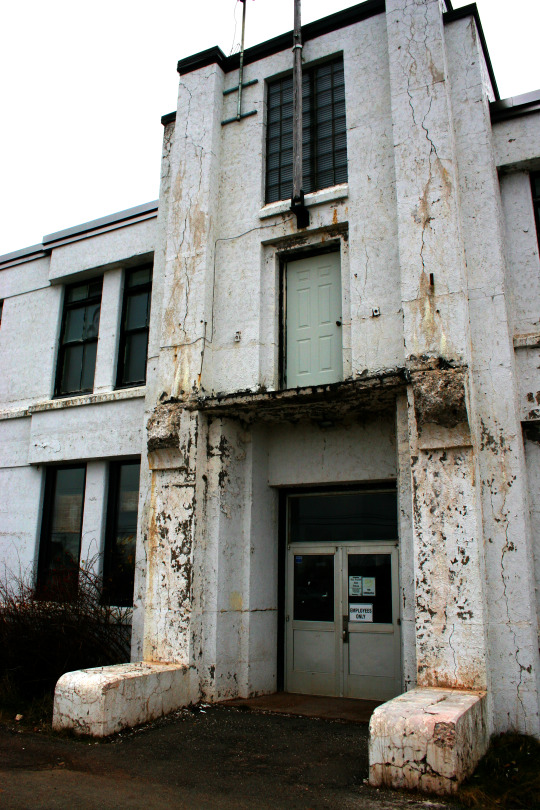
We paid a visit to my old junior high (formerly a high school) in Port Elgin, NB. The school has been closed for years now but I attended grades 7 and 8 there in 1987-89. It is now owned by Atlantic Windows and used as a warehouse, I believe.
Check out this historical excerpt from Tantramar Heritage Trust article “It Was A School Like No Other:” Port Elgin’s Regional Memorial High School:
On the evening of Sept. 7, 1948 all roads led to Port Elgin. The occasion was the official opening of the Regional Memorial School by the Lieutenant Governor Hon. D. L. MacLaren. It had been suggested that the new facility might be named in honour of Magee; but he rejected the idea. Instead he suggested that the school “be dedicated in memory of the fallen in two world wars.”
Estimates of crowds are often unreliable; however, there is agreement that on this occasion, the auditorium was “filled to overflowing;” as upwards of 1,000 people were in attendance. Magee was in the chair and confessed “with pride” that he felt like ”Joe Louis after winning a championship boxing match.” Dr. Fletcher Peacock was also present and reminisced about his long career in education.
If anybody has information about the rickety, condemned-looking old ‘Orange House’ pictured below which is situated across the road from the old school, please let me know. There must be a good story there.


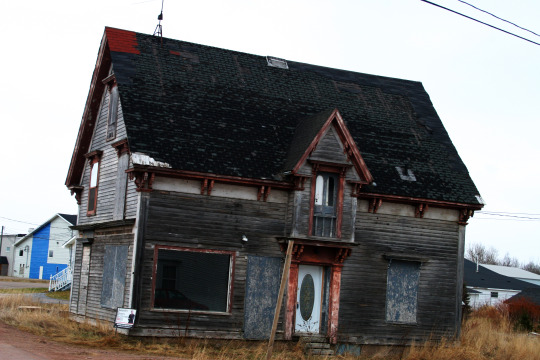

1 COMMENT:
JOHN R. MERRIAM
APRIL 24, 2014
(1) The building across the road from the school I knew as Reid’s Diner (Roy Reid). We would often go there at lunch for fries and a pop. He also had a couple of pin ball machines. He moved away sometime before I graduated and the store then closed.
I am currently 71 years old living in Berwick NS. I attended RMS from grade 7 to 12 when my family lived in Port Elgin. I graduated in 1962 or 63, then joined the RCMP.
(2) The Magee house across from the school is now a nursing home, but was once the residence of Fred Magee. Beside it were his offices where he operated a cannery for lobster and vegetables. It was located where Atlantic Windows now has a factory. The offices is now the town administration. Behind the Magee residence was a garage which partly hung over the river. Inside was a grey 1952 Packard which Magee owned. It was like new. At that time, the car would have been about 10 years old. Magee died in 1952, so he may have bought the car in the fall of 1951. There was an elderly lady living there in the early 60’s, may have been a sister or sister-in-law.
John Merriam
0 notes
Text





an early morning walk along the Tantramar river
this last week I can truly feel myself coming out of a long winter hibernation-like state.. waking up with the light .. needing less sleep .. feeling so much more energized and inspired .. April is full of so much magic
12 notes
·
View notes
Text
Dikes to protect N.S.-N.B. link from flooding expected to cost up to $300 million
An engineering study says the cost of a decade-long project to save the land link between Nova Scotia and New Brunswick from climate-related flooding will range between $189 million and just over $300 million.
The study released Friday suggests either raising the height of the existing 35 kilometres of dikes for an estimated $200 million, building a new dike at a cost of $189 million, or raising the existing dikes and installing steel sheet pile walls in select locations for about $301 million.
Whichever option is chosen, the governments of Nova Scotia and New Brunswick made clear Friday they need Ottawa to commit to a major portion -- if not the entirety -- of the cost before the project can proceed.
"The price tag on the project is in the ballpark of my capital budget for a year. It's massive," Jill Green, New Brunswick's minister of transportation and infrastructure, told an online news conference.
Kim Masland, the Nova Scotia transport minister, added: "I'd love to see it 100 per cent funded federally," though neither she nor Green ruled out a provincial contribution.
The study anticipates that once an option is chosen, it would take five years for construction to begin, and the project wouldn't be completed until 10 years after the start date. That's assuming there aren't delays arising from environmental assessments, archeological studies and consultations with First Nations.
Experts have for decades warned that the combination of high tides with a powerful storm up the Bay of Fundy could overwhelm aging dikes and flood large portions of Amherst, N.S., as well as neighbouring Sackville, N.B.
Meanwhile, the sea level at the mouth of the Bay of Fundy has been rising at a rate of about 2.4 millimetres a year over the past century due to the warming planet, even as the dikes and coastal land continue to subside.
If a flooding disaster occurs, vital transportation that carries about $35 billion in trade annually would be disrupted, and both Nova Scotia and Newfoundland and Labrador's supply of food, medicine and other essentials could be severely reduced.
The study notes that current dikes, some of them with earth foundations dating back to the Acadian settlements of the 1600s, have been gradually built up to provide protection of 8.5 metres, with the most recent major improvements in the 1950s. The refurbished dikes would add two metres, protecting the land against rising tides to a level of 10.6 metres.
Both cabinet ministers said they realize there's no guarantee a storm on the scale of the famous Saxby Gale of 1869 won't sweep back up the Bay of Fundy and submerge Amherst and Sackville again before the work is completed. However, they said the project has to be built with an eye to withstanding rising seas to at least 2100, and it is a project that will have to be made to last.
"Construction takes a long time," Green said. "This is a massive project that's not going to happen overnight."
Consultants Wood Canada Ltd. were chosen to carry out the study in January 2020, but there have been repeated delays in the date of its delivery, and it was only provided to the provinces and the federal government in January 2022. Green said the delays were related to a federal election occurring in the middle of the $700,000 study.
The analysis considered 10 options, with three making the short list.
In the first two, less expensive options, the engineers envision either adding to existing dikes, or replacing them with a new dike in some portions. Both of the options also include a water control structure across the Tantramar River that runs near Sackville.
The third and more costly $300-million option envisions raising existing dikes to 10.6 metres, a water control structure across the Tantramar River and a steel wall through the Tantramar Marsh to the Aulac River -- a distance of about 800 metres.
Green said the more expensive option is on the table as it's possible the cheaper two scenarios may encounter obstacles.
"As we move into Phase 2 of this, the archeological and environmental assessments may dictate how we move forward and what options we have on the table ... It's to be determined," she said.
David Kogon, the mayor of Amherst, said in an email that he's relieved the dikes will be raised, as he had feared the inhabited lowlands would be abandoned and that a bridge would be created solely to protect the transportation and communications corridor.
"All of the top three options presented are aimed at protecting not only the transportation corridor but the neighbouring communities, Amherst and Sackville, and the farmland contained within the marsh," he said.
This report by The Canadian Press was first published March 18, 2022.
from CTV News - Atlantic https://ift.tt/pmdqj1x
1 note
·
View note
Text
that post was the aulac river this week, this post is the tantramar river 3 years ago. photos can't capture the way the colours shift and glint, the sky reflected in the glassy mud, the swift clouds layering the river with shadows!

#i have been writing poems about this marsh for fifteen years#and i will forever#long after it is underwater#tantramar
8 notes
·
View notes
Text
"The Moose” - Elizabeth Bishop
For Grace Bulmer Bowers From narrow provinces
of fish and bread and tea,
home of the long tides
where the bay leaves the sea
twice a day and takes
the herrings long rides,
where if the river
enters or retreats
in a wall of brown foam
depends on if it meets
the bay coming in,
the bay not at home;
where, silted red,
sometimes the sun sets
facing a red sea,
and others, veins the flats’
lavender, rich mud
in burning rivulets;
on red, gravelly roads,
down rows of sugar maples,
past clapboard farmhouses
and neat, clapboard churches,
bleached, ridged as clamshells,
past twin silver birches,
through late afternoon
a bus journeys west,
the windshield flashing pink,
pink glancing off of metal,
brushing the dented flank
of blue, beat-up enamel;
down hollows, up rises,
and waits, patient, while
a lone traveller gives
kisses and embraces
to seven relatives
and a collie supervises.
Goodbye to the elms,
to the farm, to the dog.
The bus starts. The light
grows richer; the fog,
shifting, salty, thin,
comes closing in.
Its cold, round crystals
form and slide and settle
in the white hens’ feathers,
in gray glazed cabbages,
on the cabbage roses
and lupins like apostles;
the sweet peas cling
to their wet white string
on the whitewashed fences;
bumblebees creep
inside the foxgloves,
and evening commences.
One stop at Bass River.
Then the Economies—
Lower, Middle, Upper;
Five Islands, Five Houses,
where a woman shakes a tablecloth
out after supper.
A pale flickering. Gone.
The Tantramar marshes
and the smell of salt hay.
An iron bridge trembles
and a loose plank rattles
but doesn’t give way.
On the left, a red light
swims through the dark:
a ship’s port lantern.
Two rubber boots show,
illuminated, solemn.
A dog gives one bark.
A woman climbs in
with two market bags,
brisk, freckled, elderly.
“A grand night. Yes, sir,
all the way to Boston.”
She regards us amicably.
Moonlight as we enter
the New Brunswick woods,
hairy, scratchy, splintery;
moonlight and mist
caught in them like lamb’s wool
on bushes in a pasture.
The passengers lie back.
Snores. Some long sighs.
A dreamy divagation
begins in the night,
a gentle, auditory,
slow hallucination....
In the creakings and noises,
an old conversation
—not concerning us,
but recognizable, somewhere,
back in the bus:
Grandparents’ voices
uninterruptedly
talking, in Eternity:
names being mentioned,
things cleared up finally;
what he said, what she said,
who got pensioned;
deaths, deaths and sicknesses;
the year he remarried;
the year (something) happened.
She died in childbirth.
That was the son lost
when the schooner foundered.
He took to drink. Yes.
She went to the bad.
When Amos began to pray
even in the store and
finally the family had
to put him away.
“Yes ...” that peculiar
affirmative. “Yes ...”
A sharp, indrawn breath,
half groan, half acceptance,
that means “Life’s like that.
We know it (also death).”
Talking the way they talked
in the old featherbed,
peacefully, on and on,
dim lamplight in the hall,
down in the kitchen, the dog
tucked in her shawl.
Now, it’s all right now
even to fall asleep
just as on all those nights.
—Suddenly the bus driver
stops with a jolt,
turns off his lights.
A moose has come out of
the impenetrable wood
and stands there, looms, rather,
in the middle of the road.
It approaches; it sniffs at
the bus’s hot hood.
Towering, antlerless,
high as a church,
homely as a house
(or, safe as houses).
A man’s voice assures us
“Perfectly harmless....”
Some of the passengers
exclaim in whispers,
childishly, softly,
“Sure are big creatures.”
“It’s awful plain.”
“Look! It’s a she!”
Taking her time,
she looks the bus over,
grand, otherworldly.
Why, why do we feel
(we all feel) this sweet
sensation of joy?
“Curious creatures,”
says our quiet driver,
rolling his r’s.
“Look at that, would you.”
Then he shifts gears.
For a moment longer,
by craning backward,
the moose can be seen
on the moonlit macadam;
then there’s a dim
smell of moose, an acrid
smell of gasoline.
0 notes
Text

My son, Chris Mackenzie Metallic, 20 year old Aboriginal from Listuguj Quebec, was in his third year at Mount Allison University in Sackville New Brunswick and has been missing since November 25th, 2012
Chris and his friends went to a house party on Allison Avenue and had a lot to drink that night. He passed out for a bit and took his sneakers and glasses off and put his phone down. After about an hour or so, he got up again (didn't put his shoes or glasses back on and left his phone) and continued hanging out with his friends during the party. Then, he ended up outside with one of his friends and they went to another house the next street over (on Wellington avenue) Chris got sick over there and then wanted to go home and his friend wanted to go back to the party. Chris was intoxicated and he didn't realize he left his shoes at the party so his friend loan him a pair of flip flops to walk home and said he'll find his shoes the next day. The last time Chris was seen by his friend was outside the party where they split up. His friend went back to the party and Chris said he was walking home.....but didn't. This was around 2:00am and it should have only taken less than 20 minutes to walk home.
Then at approximately 5:30am, a witness saw someone walking on the Upper Abougajne road as he was driving to work. He thought it was strange for someone to be walking into that road at that hour. He then turned around and headed back towards his house and passed by him again. He was carrying 2 long sticks. The driver slowed down as he passed by him and tried to see what he was carrying (he thought that maybe they were bolt cutters). The driver then pulled in his driveway, shut off his vehicle and called the police. Then while waiting for the police (approximately 45 minutes) He seen him again still walking, still in the same direction into the woods. He was carrying white reflective driveway markers while walking. Once the police arrived, the witness gave them the description and direction he went and then headed back off to work. No one else was seen and no other vehicles were driving by. The distance and time frame show that he walked that whole way into the woods.
When Chris was officially reported missing and the news broke, the witness went out on his own to try to find him because he was sure it was Chris he saw that morning. The witness and another local man are the ones who found the flip flops. This was a couple of days after. The flip flops were confirmed by Chris' friend to be the ones he gave him that night. The footprints in the mud are Chris' foot size and the prints went towards the hay field off of White Birch Road. Dogs were brought in and couldn't track his scent anymore. The search was focused on the Tantramar River by the hay field. Divers didn't find anything of Chris' in the water and the search was called off but we continue to search the woods.
0 notes
Photo
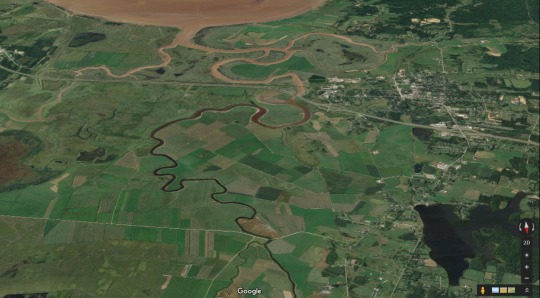

tantramar river
#home#my hometown!#usually i avoid posting evidence of humanity#except when it's really beautiful#google maps#google earth
2 notes
·
View notes
Video
youtube
Open Syllabus, ENG 210W, January 2017, Introduction to Creative Writing
Class Thirteen
Read and Discuss:
“Redeployment,” Phil Klay
http://www.businessinsider.com/redeployment-phil-klay-2014-7
Exercise:
Describe an animal.
Read, Aloud:
“Grazing Horses,” Kay Ryan
https://www.poetryfoundation.org/poetrymagazine/browse?contentId=40074
“Peek-a-Moose,” Mary Reufle
https://www.goodreads.com/book/show/2459339.The_Most_of_It
Perspectives on Animals
Listen to:
“Cat ‘n’ Mouse,” John Abercrombie
youtube
“Lazy Bird,” John Coltrane
youtube
Read, Aloud:
“The Moose,” Elizabeth Bishop
From narrow provinces
of fish and bread and tea,
home of the long tides
where the bay leaves the sea
twice a day and takes
the herrings long rides,
where if the river
enters or retreats
in a wall of brown foam
depends on if it meets
the bay coming in,
the bay not at home;
where, silted red,
sometimes the sun sets
facing a red sea,
and others, veins the flats’
lavender, rich mud
in burning rivulets;
on red, gravelly roads,
down rows of sugar maples,
past clapboard farmhouses
and neat, clapboard churches,
bleached, ridged as clamshells,
past twin silver birches,
through late afternoon
a bus journeys west,
the windshield flashing pink,
pink glancing off of metal,
brushing the dented flank
of blue, beat-up enamel;
down hollows, up rises,
and waits, patient, while
a lone traveller gives
kisses and embraces
to seven relatives
and a collie supervises.
Goodbye to the elms,
to the farm, to the dog.
The bus starts. The light
grows richer; the fog,
shifting, salty, thin,
comes closing in.
Its cold, round crystals
form and slide and settle
in the white hens’ feathers,
in gray glazed cabbages,
on the cabbage roses
and lupins like apostles;
the sweet peas cling
to their wet white string
on the whitewashed fences;
bumblebees creep
inside the foxgloves,
and evening commences.
One stop at Bass River.
Then the Economies—
Lower, Middle, Upper;
Five Islands, Five Houses,
where a woman shakes a tablecloth
out after supper.
A pale flickering. Gone.
The Tantramar marshes
and the smell of salt hay.
An iron bridge trembles
and a loose plank rattles
but doesn’t give way.
On the left, a red light
swims through the dark:
a ship’s port lantern.
Two rubber boots show,
illuminated, solemn.
A dog gives one bark.
A woman climbs in
with two market bags,
brisk, freckled, elderly.
“A grand night. Yes, sir,
all the way to Boston.”
She regards us amicably.
Moonlight as we enter
the New Brunswick woods,
hairy, scratchy, splintery;
moonlight and mist
caught in them like lamb’s wool
on bushes in a pasture.
The passengers lie back.
Snores. Some long sighs.
A dreamy divagation
begins in the night,
a gentle, auditory,
slow hallucination....
In the creakings and noises,
an old conversation
—not concerning us,
but recognizable, somewhere,
back in the bus:
Grandparents’ voices
uninterruptedly
talking, in Eternity:
names being mentioned,
things cleared up finally;
what he said, what she said,
who got pensioned;
deaths, deaths and sicknesses;
the year he remarried;
the year (something) happened.
She died in childbirth.
That was the son lost
when the schooner foundered.
He took to drink. Yes.
She went to the bad.
When Amos began to pray
even in the store and
finally the family had
to put him away.
“Yes ...” that peculiar
affirmative. “Yes ...”
A sharp, indrawn breath,
half groan, half acceptance,
that means “Life’s like that.
We know it (also death).”
Talking the way they talked
in the old featherbed,
peacefully, on and on,
dim lamplight in the hall,
down in the kitchen, the dog
tucked in her shawl.
Now, it’s all right now
even to fall asleep
just as on all those nights.
—Suddenly the bus driver
stops with a jolt,
turns off his lights.
A moose has come out of
the impenetrable wood
and stands there, looms, rather,
in the middle of the road.
It approaches; it sniffs at
the bus’s hot hood.
Towering, antlerless,
high as a church,
homely as a house
(or, safe as houses).
A man’s voice assures us
“Perfectly harmless....”
Some of the passengers
exclaim in whispers,
childishly, softly,
“Sure are big creatures.”
“It’s awful plain.”
“Look! It’s a she!”
Taking her time,
she looks the bus over,
grand, otherworldly.
Why, why do we feel
(we all feel) this sweet
sensation of joy?
“Curious creatures,”
says our quiet driver,
rolling his r’s.
“Look at that, would you.”
Then he shifts gears.
For a moment longer,
by craning backward,
the moose can be seen
on the moonlit macadam;
then there’s a dim
smell of moose, an acrid
smell of gasoline.
https://www.poetryfoundation.org/resources/learning/core-poems/detail/48288
2 notes
·
View notes
Text

Tantramar River
31 notes
·
View notes
Text

In League
32 notes
·
View notes
Text
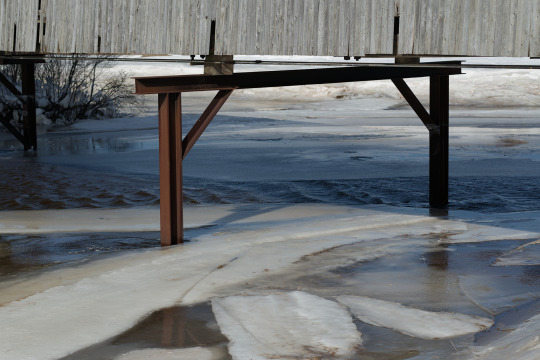
Breaking Up
20 notes
·
View notes
Text
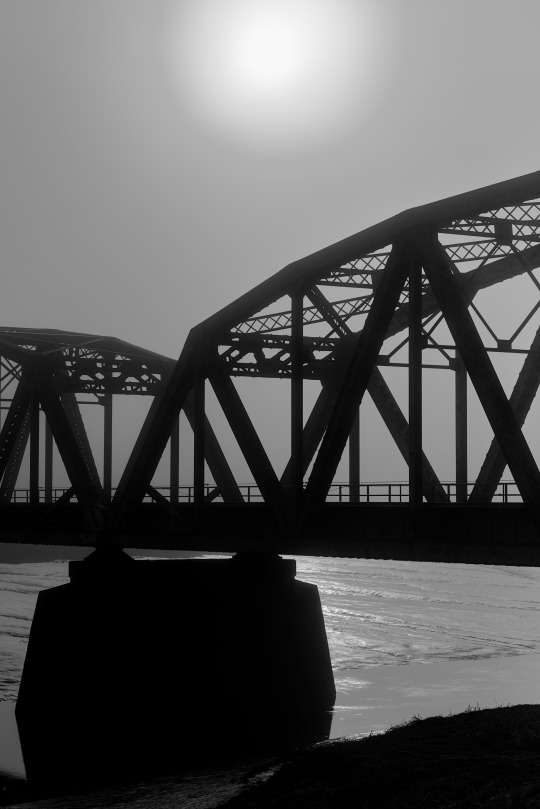
Away From Here
47 notes
·
View notes
Text
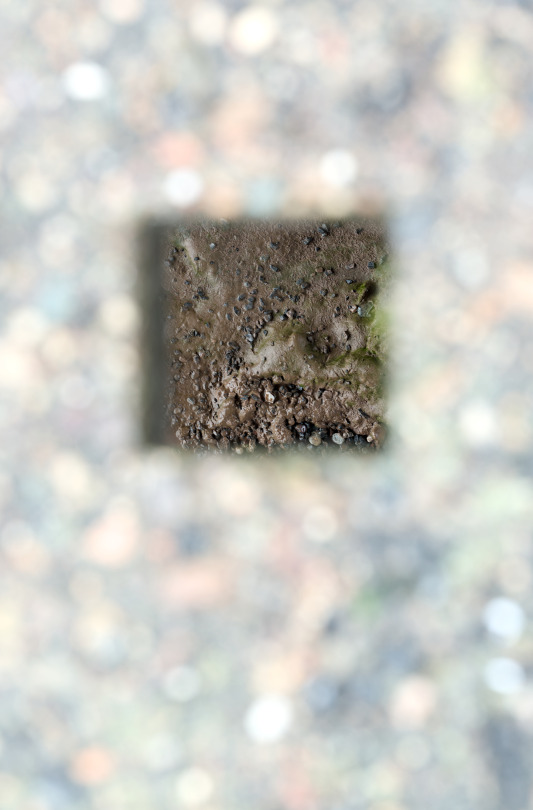
Under the Bridge
38 notes
·
View notes
Text
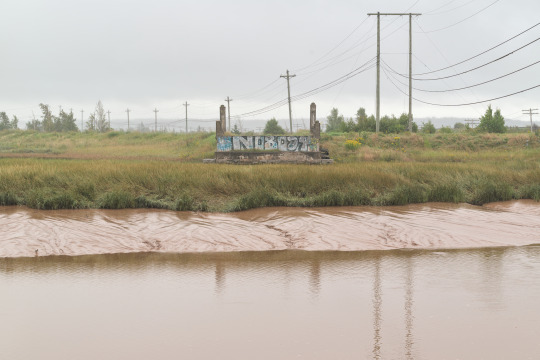
No Bridge
33 notes
·
View notes